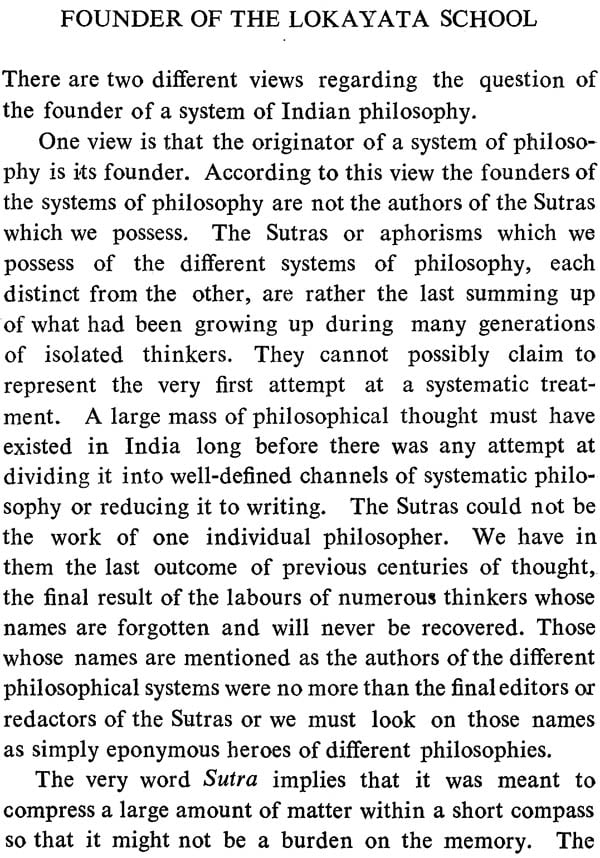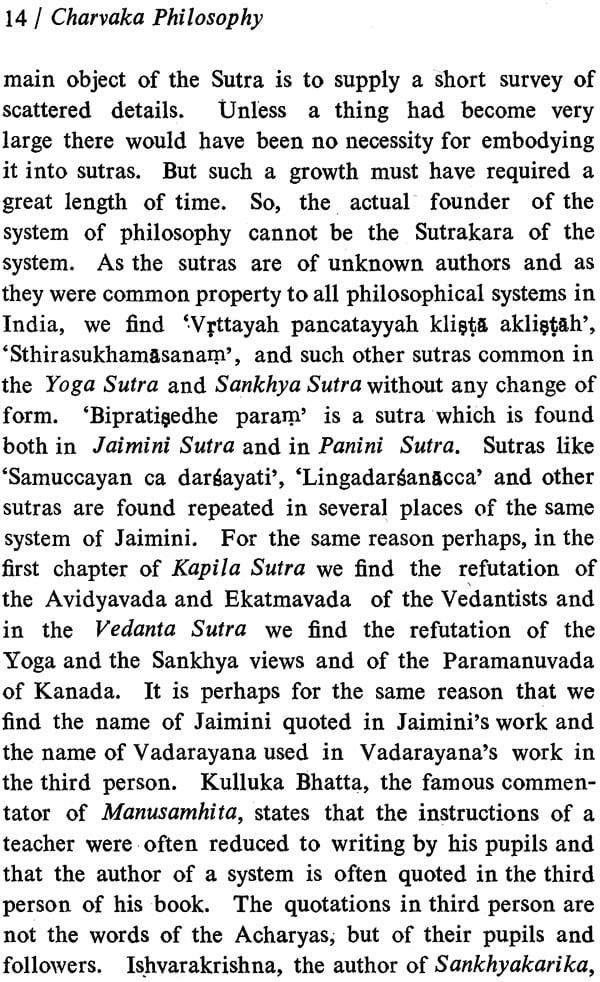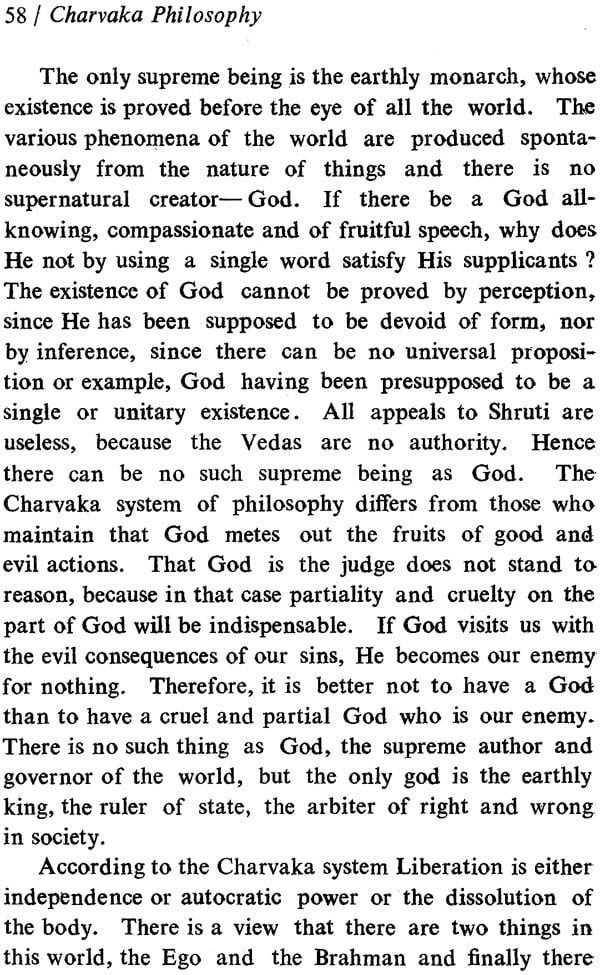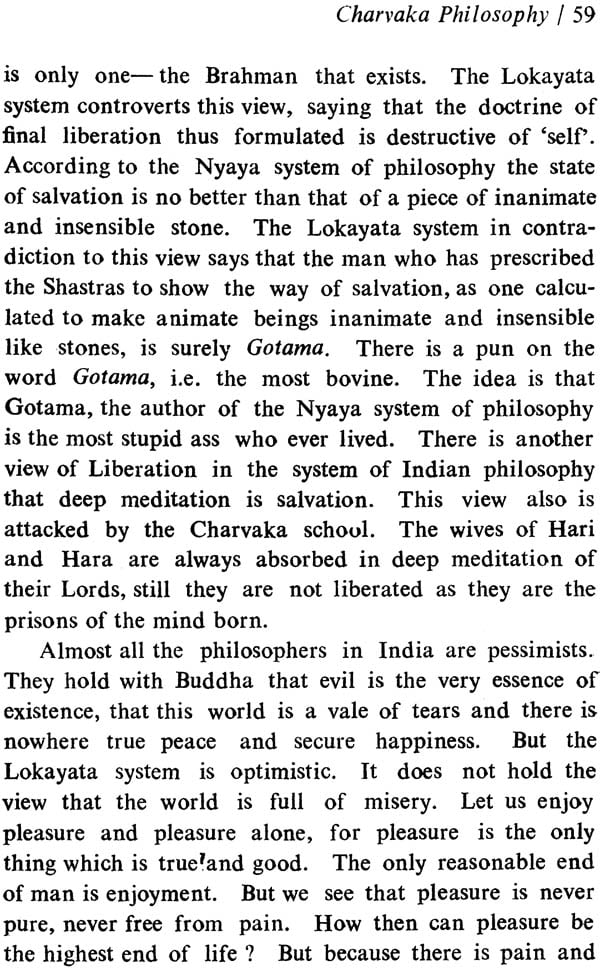
Charvaka Philosophy (An Old and Rare Book)
Book Specification
| Item Code: | NAM015 |
| Author: | Dr. Dakshinaranjan Shastri |
| Publisher: | Rabindra Bharati University |
| Language: | English |
| Edition: | 1967 |
| ISBN: | 8186438025 |
| Pages: | 80 |
| Cover: | Hardcover |
| Other Details | 7.0 inch x 5.0 inch |
| Weight | 150 gm |
Book Description
Dakshinaranjan Shastri (1894-1961) was born at Amtoli village in the Faridpur district (now a province) of Bangladesh. His schooling through Sanskrit Collegiate School and College and finally at the University of Calcutta led him to the 1st in 1st class position in M.A. in Sanskrit. He also did an M.A. in Bengali, and received the title ‘Shastri’ from the D.P.I., Bengal. His Ph.D thesis was on ‘The Origin and Development of the Rituals of Ancestor Worship in India’. He had taught briefly at Sanskrit Collegiate School before becoming a teacher at Sanskrit College. His last job was that of the Head of the Department of Sanskrit at Krishnagar Government College.
Shastri could write English, Bengali and Sanskrit with equal facility. His publications are Charvaka Shasthi (1928, Sanskrit and English), Bhasa Samasya O Mimamsa (1929, Bengali), A Short History of Indian Materialism and Hedonism (1930), Charvaka Darshana (1959, Bengali). Strangely, his thesis for Ph.D. was rather late to be published (1962). Two other posthumous publications are Charvaka Philosophy (1967) and Smriti: Achar O Dharma (1974, Bengali).
He wrote extensively in various scholarly journals which include Historical Quarterly, The Cultural Heritage of India, The Religions of the World, Journal of the Indian Society of Oriental Art, The Humanist Way, Philosophy of East and West etc., as he wrote in numerous Bengali periodicals. In 1960, he was invited to attend the International Congress of Orienta-lists which was held in Moscow, which, however, he could not attend for failing health.
If we can really claim that we live in an age of reason, we must also acknowledge that such an age should admit only one philosophy which assigns a priority of matter over mind. To do this is not to become materialistic in the pejorative sense of the term, but to hold a worldview that reason and ground realities of this planet allow us to hold. That the world has still witnessed the growth of host of philosophies which I regard as fascinating fictions and that these philosophies have held sway in most countries most of the time, cannot be anything but in instance of truth being submerged by a deluge of falsehood. The factors behind this topsy-turvy progress of ideas are too complex and wide-ranging to be worth our while to go into now. What, however, is encouraging is the fact that the ancient world, including India, did not let this happen without a fight and the Charavaka or Barhaspatya philosophy, now accepted as a valid, although much maligned, member of the set of six systems of Indian philosophy, presents a dialectics of ideational struggle, in an otherwise insipid chronicle of the overwhelming preponderance of the so-called ‘spiritualism’.
This spiritualistic philosophies, to my mind, did precious little to explain the world and our life in it: the whence, when, how, and why of them. They are, in fact, no better than the fibbing of the kid charged for not doing his homework. Charvaka, on the other hand, keeps his nose close to the ground, and calling a spade a spade, tells us in a bland manner that the king wore no cloth. He puts too many questions to the thesis for them to-feel comfortable, and generations to the latter did their utmost to destroy the traces of his philosophy. They even gobbled up atheistic Buddhism, having mystified it out of recognition. But the dogged persistence of materialism, and its refusal to die, show that at no point of time was their victory complete.
Charvaka, or his tradition, represents a heroic resistance to spiritualism and everything that goes with it and creates a human face of ancient India, otherwise overlooked by us. He therefore is more relevant now than he has ever been. A no-nonsense and businesslike philosophy like his, minus its hedonistic excesses (which may well be interpolations by its antagonists), is a near thing to the philosophy that works, the philosophy that explains things as it attempts as changing them.
Late Dakshinaranjan Shastri was one of the best exponents of Indian materialism, and we are glad that we are able to offer this small volume on the Charvaka system, an excellent introduction to it, to mark the author’s centenary of birth, which fell in 1994. I hope that the readers of the present generation, who have not forsaken the dream of changing the world, will and find the book stimulating and inspiring.
It is well known to the students of Indian Philosophy that the original Sutra works of Charvaka Philosophy are now lost to us. It is also known that it is not always safe to rely exclusively for a certain doctrine or way of thought on its presentation by its avowed opponents. Opponents are seldom found to be free from prejudices and personal predilections, the absence of which is necessary for studying a problem dispassionately and for examining it on its own merits. Purvapaksas or the opponent views are almost invariably presented in an inadequate and unsympathetic manner so that no sound judgment as to their proper philosophical worth can be easily formed. For this obvious reason the study of a system from its perverted presentation by its opponents has to be supplemented by method of sympathetic introspection.
The study of the Charvaka philosophy should, therefore, be attempted on the broad basis of sympathetic appreciation. We must always be prepared to distinguish between what a certain thinker says of himself and what others unfavourably disposed towards him attribute to him. For this obvious reason, utmost attempt is to be made to collect fragments of actual statements of the founders and propounders of Charvaka view. We have a vast and curious medley of utterances in the subsequent literature which were inspired by a spirit of positive hatred and deprecation. The views of the opponents are, therefore, to be studied in the light of consistency with the spirit of the fragments yet preserved, of the actual words used by the earliest champions of the system.
It is not enough to know what views a particular thinker holds. We should try, if we have to build up a system of thought, to trace these views to a rational basis amenable to the understanding of man.
The materialist school of India is known by different names. Some call it Lokayata or Charvaka, whereas others call it Nastika or Barhaspatya.
Lokayata
Kumarila Bhatta uses the word Lokayata in the sense of an atheistic system in general. He says in his Sloka Vartika that Mimamsa has been treated in the world as Lokayata on account of its supposed atheism. But a system should not be considered as Lokayata on account of its mere atheistic character. The Buddhists, excluding those of the later Mahayana school, the Jainas, Sankhya, at least in its ancient form and Vaisesika did not believe in a personal God. Yet we know Lokayata to be quite distinct from all these schools. So atheism cannot be the peculiar characteristic of the Lokayata school. Mimamsa does not believe in a personal God, but believes in karmaphala i.e. fruits of good and evil actions. Lokayata denies karmaphala, a sentiment never doubted by any Hindu. It is this denial of karmaphala which opens a /??chasm between it and the other schools. Hence, although Lokayata is an atheistic system, all atheistic systems are not Lokayata. So we cannot accept the view of Kumarila in this matter. Childers explains the word Lokayata as controversy on fabulous or absurd points. This view is criticized by Max Muller who refers to the Ambattha-Sutta where Lokayata is mentioned as forming part of the studies proper for a Brahmana. Kautilya, in his Arthashastra mentions Lokayata along with Sankhya and Yoga systems. So we cannot admit Childer’s view. Davids and Franke explain it as a doctrine specially aiming at studying nature and the laws of nature. Tucci contradicts this view. He says that Loka never had in Sanskrit the meaning of nature. Lokayata is but a science which has for its only object the Loka i.e. this world. Rajkrishna Mukhopadhyay gives the following explanation of the word Lokayata: “The other name of the Charvaka system is Lokayata, because it holds that only this world or Loka exists.”
Dr. Dasgupta explains it in the following manner: “Lokayata (literally that which is found among people in general) seems to have been the name by which all Charvaka doctrines were generally known. According to Radhakrishnan, Lokayata is the Sanskrit word for Materialism. The Materialists are called Lokayatas. This interpretation receives a strong support, for Lokayata may be etymologically analysed as ‘Loka’ and ‘Ayata’—‘prevalent in the world’. Brihaspati in Arthashastra, Kautilya, Vatsyayana, Haribhadra Suri, Abhidhakarna, Shanta Raksita, Sankaracharya, Vachaspati Mishra, Bhaskaracharya, Krishna Mishra, Gunaratna, Nilakantha, Madhusudana, Madhavacharya and Jayarashi use the word Lokayata in the sense of a Materialistic school of philosophy.
The word Lokayata is as old as the Ramayana. In the Ramayana the word Lokayata means Vitanda (dry arguments or casuistry). It is often used in old Pali text in the same sense. The word is also available in Patanjali’s Mahabhashya. The name Lokayata also occurs in Panini’s Ukthadigana. Lokayata has been recognised by Kautilya as a Darshana.
Charvaka
The other name of the materialistic school is Charvaka. According to Max Muller, Charvaka is represented as a teacher of Lokayata. He is treated as a historical individual to whom Brihaspati or Vachaspati delivered his doctrine. The doctrines of Buddha would be called sceptical and atheistical by the Brahmanas, and Charvaka as well as Nastika is the name freely applied to the Buddhists. But the doctrines of Charvaka as far as we know them, go far beyond Buddhism and may be said to be hostile to all religious feelings, while Buddha’s teaching was both religious and philosophical. Radhakrishnan, along with Macdonell, holds that Charvaka is the name of the founder of the Lokayata system. Dr. Dasgupta explains the word Charvaka in a different way. He says that Charvaka is not any historical individual. The Lokayatas were called Charvakas, because they would only eat (‘oharv’ to eat) but would not accept any religious or moral responsibility. L. de La Valle Poussin mentions Charvaka as the reputed founder of the sect. Dr. B. Barua holds the view that the later Sanskrit works ascribe materialistic utterances to a mythical figure to whom they give the name of Charvaka.
Let us assume, along with Krishna Mishra and MM. Vasudeva Sastri that Charvaka was one of the followers of Brihaspati of the Lokayata school like Bhaguri, mentioned in Patanjali’s Mahabhasya and like Kambala-shwatara as well as Purandara mentioned in the Tattva Samgraha of Shanta Rakshita.
Charvaka is met with in the Mahabharata. Later on this is the only term by which Indian materialism is designated.
The word Charvaka is often taken as Charu (beautiful) and Vak (speech). And it is interesting to find that Charu is also a synonym for Brihaspati. Thus it may be suggested that Charvaka stands for ‘the words of Brihaspati’.









